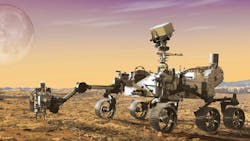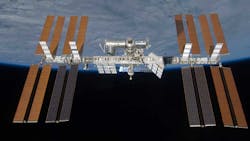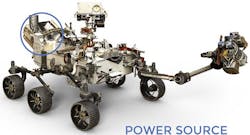Achieving Power Density for NASA Aircraft and Mars Rovers
This article is part of the Power Management Series: Delving Into Power Density
Members can download this article in PDF format.
What you'll learn:
- The role of solar energy in modern satellite systems.
- The use of solar arrays in the ISS.
- Solar-generation systems in mini satellites.
- What powers the Perseverance rover?
In 2019, small spacecraft with a mass under 180 kg made up almost 7% of all mass launched into orbit. And 63% of spacecraft under 600 kg had mass less than 180 kg—47% of those were CubeSats. Since 2013, CubeSat flights have nearly doubled.
Dedicated SmallSat launch capabilities also create easily available and expanding opportunities to demonstrate new technologies and systems. Powering these satellites is a challenge and power density is crucial.
Beyond the SmallSats, the International Space Station (ISS) and the Mars Rovers face challenges for sustained power, too. Again, power density is a critical issue in these applications. How can designers achieve power density as well as a viable source of power in space for such spacecraft?
The Solution: Solar Energy
Electrical power systems (EPS) encompass electrical power generation, storage, and distribution in the spacecraft. The EPS is a critical and fundamental subsystem that usually comprises up to one-third of total spacecraft mass and volume. Power-generation technologies can include photovoltaic (PV) cells, solar panels and arrays, and radioisotope or other thermonuclear power generators. In this article, we will discuss solar-panel and -array storage that usually will be in the form of either single-use primary batteries or rechargeable secondary batteries.
Power management and distribution (PMAD) systems help provide power control to spacecraft loads. PMAD can take a variety of forms and is frequently custom-designed to meet specific mission requirements. EPS design engineers target a high specific power or power-to-mass ratio (Wh/kg) when selecting power generation and storage technologies to minimize system mass impact. The volume is more likely to be the constraining factor, especially with nanosatellites. High power density also is crucial in these systems; a typical value is 90 to 110 W/m3.
The information described in this article isn’t intended to be exhaustive but provides an overview of current state-of-the-art technologies and their development status for the ISS, Mars Rover, and small spacecraft subsystems. It should be noted that Technology Readiness Level (TRL) designations may vary with changes specific to payload, mission requirements, reliability considerations, and/or the environment in which performance was demonstrated.
Readers are highly encouraged to reach out to companies for further information regarding the performance and TRL of the described technology. There’s no intention of mentioning certain companies and omitting others based on their technologies or relationship with NASA.
International Space Station (ISS)
The ISS orbits 220 miles above the Earth and needs quite a bit of power to support life and power all ISS systems such as light, breathable air, experiments, and so much more for the astronauts and mission specialists. Thus, power density becomes crucial on the ISS (Fig 1).
The ISS employs a Roll-Out Solar Array (ROSA) architecture, which is an innovative new solar-array design that uses high strain, one-piece, composite slit-tube booms. The stored strain energy of the booms enforces the deployment actuation, and the booms provide the array's deployed structural stiffness and strength.
When the orbiting station is in sunlight, 60% of the direct-current (dc) electricity from the solar arrays charges the station's batteries. However, there are times when some or all of the solar arrays find themselves in the shadow of Earth or the shadow of part of the ISS itself. Thus, of course, many of those arrays aren’t collecting sunlight. Therefore, batteries power the ISS when it’s not in the sun (Fig 2).
NASA astronauts Mike Hopkins and Victor Glover went on a spacewalk on February 1st, 2021 to complete a multi-year effort replacing the aging nickel-hydrogen batteries on the ISS with new lithium-ion models. The upgrade is finally complete.
ISS Solar Array Facts
- Together the arrays contain a total of 262,400 solar cells and cover an area of about 27,000 square feet (2,500 square meters)—more than half the area of a football field.
- A solar array's wingspan of 240 feet (73 meters) is longer than a Boeing 777's wingspan, which is 212 feet (65 meters).
- The space station's electrical power system is connected by eight miles (12.9 kilometers) of wire.
Photovoltaic cells, or solar cells, are made from thin semiconductor wafers that produce electric current when exposed to light. The light available to a spacecraft solar array, also called solar intensity, varies as the inverse square of the distance from the sun. The projected surface area of the panels exposed to the sun also affects generation and varies as a cosine of the angle between said panel and the sun.
Limitations to solar-cell use include diminished efficacy in deep-space applications, no generation during eclipse periods, degradation over mission lifetime (due to aging and radiation), high surface area, mass, and cost.
SmallSat
To pack more solar cells into limited volume in SmallSats and NanoSats, mechanical deployment mechanisms can be added, which may increase spacecraft design complexity, reliability, and risk. Achieving high power density is crucial.
Small satellites usually have a range of power requirements from as little as a watt or two to a few kilowatts. Small low-Earth-orbit (LEO) nanosatellite and microsatellite power-system designs will be more challenging due to space/weight constraints.
While single-junction cells are cheap to manufacture, they carry a relatively low efficiency, usually less than 20% (they’re not included in this article). Modern spacecraft designers favor multi-junction solar cells. These are made from multiple layers of light-absorbing materials that efficiently convert specific wavelength regions of the solar spectrum into energy, thereby using a wider spectrum of solar radiation.
The theoretical efficiency limit for an infinite-junction cell is 86.6% in concentrated sunlight. However, in the aerospace industry, triple-junction cells are commonly used due to their high efficiency-to-cost ratio compared to other cells.
CubeSat
CubeSats are a kind of “kit” form of a SmallSat in a standard form factor:
- 1 kg, 10- × 10- × 10-cm cube = 1 unit = 1U
- Designers may combine basic units to form larger CubeSats (e.g., 3U, 6U, higher)
Nanosatellite
Nanosatellites are any satellite weighing less than 10 kilograms.
Solar-power generation is the predominant method of power generation on any small spacecraft. As of 2020, approximately 85% of all nanosatellite-form-factor spacecraft had solar panels and rechargeable batteries. Again, here, high power density is a necessary goal.
Mars Perseverance Rover
The Perseverance’s main power system is a plutonium radioisotope called a "Multi-Mission Radioisotope Thermoelectric Generator" (MMRTG). This power system produces a solid flow of electricity using the heat of plutonium's radioactive decay as its "fuel." The Rover subsystems are the flight computer, motor control, radar, and mission instrument suite. These subsystems get their primary power from the MMRTG. They’re followed by the integration of high-reliability space-grade MOSFETs, ICs, and other lower-power control products that ensure reliable operation to these systems in the harsh space environment on Mars.
This power system charges the Rover's two primary lithium-ion batteries. An important role of the heat from the MMRTG is to keep the Rover's tools and systems at their optimum operating temperatures. The MMRTG has a 14-year operational lifetime, which provides a significant reserve for the Mars 2020 prime mission duration of 1.5 Mars years (three Earth years)
The power density of the Mars Perseverance Rover cylindrical power supply is 110 W/(Pi × [0.64 m diameter/2]2 × 0.66 m height) = 517.87 W/m3 (Fig 3).
Summary
One of the primary components for NASA spacecraft is the solar array, and the EPS and PMAD systems round out the general architecture for most types of spacecraft. Batteries also are part of spacecraft design—when the spacecraft is periodically blocked by the sun, batteries will continue to power the vehicle and its systems.
The ISS has a full complement of solar arrays, while small satellites typically use solar power as their main source of power. Designers must achieve as high a power density as possible in these architectures.
The Mars Rovers, particularly the last two—the Curiosity and Perseverance Rovers—have a unique power architecture based on radioisotopes with plutonium as the main power source. Rechargeable lithium-ion batteries are called into temporary action when Rover activity demands peak and exceed the radioisotope main generator’s steady normal output. Once again, high power density is a necessary goal for designers.
Read more articles in the Power Management Series: Delving Into Power Density
References
- NASA Glenn Research Center Solar Cell Experiment onboard the International Space Station, 2016
- “A Single Chip Standalone Water Splitting Photoelectrochemical Cell,” Journal of Technology Innovations in Renewable Energy, 2014, 3, 6-11
- “About the Space Station Solar Arrays,” NASA website
- A Basic Guide to Nanosatellites, Alen
- “Power System Design for Earth Orbiting Satellites,” Dr. Ugur Guven, Aerospace Engineer (PhD), Nuclear Engineer (MSc)
- “State of the Art of Small Spacecraft Technology,” NASA
- NASA astronauts complete multi-year project to upgrade batteries on the ISS, MSN
- NASA Mars Curiosity Rover electrical power
- Power, NASA



